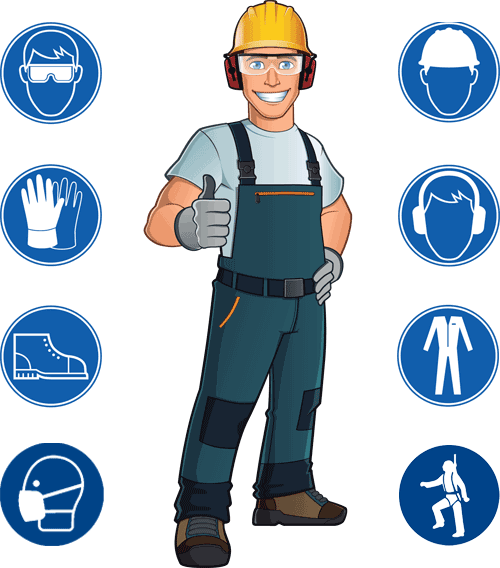The term ‘Personal Protective Equipment’ (PPE) refers to a vast group of products (e.g. safety helmets, safety footwear and harnesses, eye protection, gloves, high-visibility clothing, etc.) designed with the aim to protect users against low-, medium- and high-level hazards. This group of products is regulated by the European Directive (EU) 2016/425.
PPE, falling under the scope of the above-mentioned Directive, is intended for use in work and home activities, as well as in leisure and sports events. Such activities can bring harm to the user’s body in various ways. To ensure a user’s health and safety in any risky situation, a proper type of PPE must be held or worn. In this regard, there are eight types of personal protective equipment critical for protecting users against hazards.
- Head Protection
Wearing PPE for head protection will help you avoid any harm that may come to you from falling materials or swinging objects. Moreover, the head protectors are designed to protect you from knocking against stationary objects. Some kinds of head protection equipment (e.g. caps and hairnets) can even protect against entanglement or scalping on machinery.
Examples of head protection equipment:
- Helmets;
- Hard hats;
- Bump Caps;
- Guards;
Examples of activities where you may need head protection:
Workplace related: construction or building repair (e.g. renovation, restoration, etc.) and work in tunnels or excavations;
- Leisure/Sport related: driving motorcycles.
- Hand protection
Arms, hands and fingers are often injured, and, therefore, it is vital to wear hand protection equipment when required. The hand protection equipment can ensure protection against heat, cold, vibrations, burns, cuts by sharp objects, bacteriological risks and chemical contamination.
Examples of hand protection equipment:
- Work gloves and gauntlets;
- Wrist cuff arm nets.
- Activities requiring hand protection equipment:
- Construction and outdoor work;
- Working with vibrating apparatus;
- Working in hot or cold environments;
- Working with chemicals and hazardous elements;
- Manual handling of abrasive or sharp objects.
III. Eye and face protection
Numbers are scary! Every day, 600+ workers worldwide suffer from eye injuries. Such injuries can be avoided simply by wearing the proper eye and face protection equipment. As examples of such PPE, the following ones can be mentioned:
- Safety glasses and goggles;
- Eye and face shields;
- Eyewear accessories;
- Over specs;
- You are encouraged and advised to wear eye and face protection equipment when:
- Working with lasers or power-driven tools;
- Using gas or vapour under pressure;
- Performing welding operations;
- Handling hazardous substances.
- Respiratory protection
The respiratory protection covers a broad group of PPE: breathing apparatus, full face or half-mask respirators, powered respirators, protective hoods, disposal face masks, detectors, monitors, etc. Adequate training on how users should use the equipment is always required.
This type of PPE must be present when in contact with large amounts of gases, powders, dust and vapours.
- Hearing protection
The hearing protection equipment is vital when working in an environment with high-sound levels. The type of hearing protection should not only be suitable for the working environment but also provide a level of hygiene and comfort to the users. A good practice is to provide employees with a range of protectors and then allow them to select the ones which suit them the best.
Examples of hearing protection equipment:
- Earplugs and defenders;
- Noise meters;
- Communications sets;
- Acoustic foam.
- Foot protection
The foot protection equipment is designed to protect the feet and legs against various hazards, such as extreme temperatures, crushing, piercing, slipping, cutting, chemicals and electricity. It is typically required when users are involved in construction activities, working in very cold or hot environments, working with chemicals and forestry, or manually handling heavy objects.
- As examples of foot protection equipment, the following can be pointed out:
- Safety boots and shoes;
- Anti-static and conductive footwear.
VII. Body protection
- Usually, body protection equipment is required in the following cases:
- For protection against weather conditions when working outdoors;
- Ensuring the high-visibility of users when they work in areas where there is a mixed vehicle (e.g. bikes, motors, cars and busses) and pedestrian traffic;
- For users’ protection against extreme temperatures;
- Ensuring protection against entanglement, drowning, chemical contamination, etc.
- Examples of body protection equipment:
- Life jackets;
- Clothing for specific weather conditions;
- High-visibility clothing;
- Harnesses, and others.
VIII. Height and access protection
This type is highly specialised, and it usuall requires users to undergo thorough training before they are allowed to use it. The height and access protection equipment must be inspected periodically by a competent person to ensure it is still fit for use and the health and safety of users is not threatened in any way.


